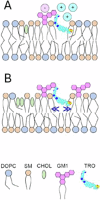Anti-aging properties of the aminosterols of the dogfish shark
- PMID: 39702521
- PMCID: PMC11659403
- DOI: 10.1038/s41514-024-00188-8
Anti-aging properties of the aminosterols of the dogfish shark
Abstract
The development of anti-aging drugs is challenged by both the apparent complexity of the physiological mechanisms involved in aging and the likelihood that many of these mechanisms remain unknown. As a consequence, the development of anti-aging compounds based on the rational targeting of specific pathways has fallen short of the goal. To date, the most impressive compound is rapamycin, a natural bacterial product initially identified as an antifungal, and only subsequently discovered to have anti-aging properties. In this review, we focus on two aminosterols from the dogfish shark, Squalus acanthias, that we discovered initially as broad-spectrum anti-microbial agents. This review is the first to gather together published studies conducted both in vitro and in numerous vertebrate species to demonstrate that these compounds target aging pathways at the cellular level and provide benefits in multiple aging-associated conditions in relevant animal models and in humans. The dogfish aminosterols should be recognized as potential anti-aging drugs.
© 2024. The Author(s).
Conflict of interest statement
Competing interests: The authors declare no competing interests.
Figures



Similar articles
-
Aminosterols from the dogfish shark Squalus acanthias.J Nat Prod. 2000 May;63(5):631-5. doi: 10.1021/np990514f. J Nat Prod. 2000. PMID: 10843574
-
The synthesis of spermine analogs of the shark aminosterol squalamine.Steroids. 2002 Mar;67(3-4):291-304. doi: 10.1016/s0039-128x(01)00161-1. Steroids. 2002. PMID: 11856553
-
Squalamine and Its Aminosterol Derivatives: Overview of Biological Effects and Mechanisms of Action of Compounds with Multiple Therapeutic Applications.Microorganisms. 2022 Jun 13;10(6):1205. doi: 10.3390/microorganisms10061205. Microorganisms. 2022. PMID: 35744723 Free PMC article. Review.
-
UT-1 Transporter Expression in the Spiny Dogfish (Squalus acanthias): UT-1 Protein Shows a Different Localization in Comparison to That of Other Sharks.Biomolecules. 2024 Sep 12;14(9):1151. doi: 10.3390/biom14091151. Biomolecules. 2024. PMID: 39334917 Free PMC article.
-
The rectal gland of Squalus acanthias: a model for the transport of chloride.Kidney Int. 1996 Jun;49(6):1552-6. doi: 10.1038/ki.1996.223. Kidney Int. 1996. PMID: 8743453 Review.
Cited by
-
Guardians of the sea: molecular and biochemical adaptations in sharks and whales for atherosclerosis resistance and their potential in human cardioprotection.Diabetol Metab Syndr. 2025 Jul 25;17(1):293. doi: 10.1186/s13098-025-01868-5. Diabetol Metab Syndr. 2025. PMID: 40713828 Free PMC article. Review.
References
Publication types
LinkOut - more resources
Full Text Sources
Research Materials

